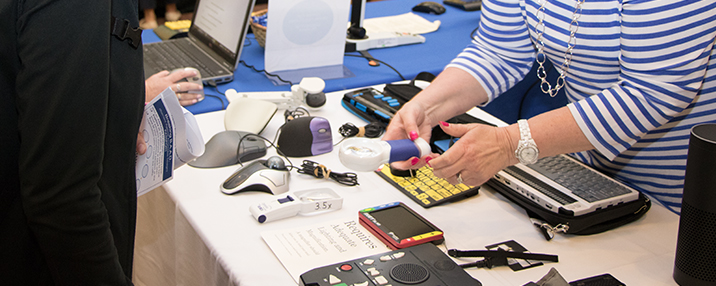The array of AT that’s available through CDS can enhance the life of most anyone with a disability. Discover, sample or acquire accessible devices that can support people of any age and income, individuals with developmental disabilities and individuals with physical disabilities. Family members and support professionals also stand to benefit from AT’s unlimited applications. Learn about them, below.
Delaware Assistive Technology Initiative (DATI)
DATI services help people learn about AT options and acquire the devices that can support them at work, school, home and in the community.
DATI demonstrations compare features and benefits of particular devices. Loans let people with disabilities, their families and the professionals who serve them borrow AT devices that can aid decision-making, fill a gap while the person is waiting for device repair or funding, provide a short-term accommodation, or provide the opportunity to become familiar with a product’s operation.
The AT Exchange works like the want ads, offering listings of products people wish to sell or donate and listings of products that people want to use.
DATI also offers programs that provide assistive technology at no cost to individuals who have no other means to obtain it.
Accessible Instructional Materials (AIM) Delaware
Students can’t learn if they can’t access the curriculum, and federal law mandates that students with print disabilities have alternative ways to access what’s in textbooks and other core curricular materials. Sometimes this means bypassing print—using Braille or audio formats. Other times it means supporting the student with large print, customized page layouts or software that highlights print while the text is read aloud by the computer.
CDS operates the Delaware AIM Center, a resource to students, families and educators. It offers training about the federal mandate, how to determine if a student has a qualifying print disability, and how to determine what type of AIM best meets a student’s needs. The Center also provides free accessible materials to Delaware public schools serving students with print disabilities.
Assistive Technology From Birth To Five
All children who need it should have the assistive technology necessary to support their participation in everyday early childhood and family routines and activities.
Even when used for only short periods, assistive technology offers great benefits to young children with disabilities. Nevertheless, young children who receive early intervention services or preschool special education frequently don’t have assistive technology included in their service plan.
fabricATe
Search fabricATe for ideas on simple and low-cost adaptations to everyday items that promote young children’s participation in everyday activities and routines. The CDS-created fabricATe initiative offers a model for providing simple, customized devices made from common materials to consumers, family members, advocates and service providers at no or low cost.
Communities are encouraged and welcome to replicate the fabricATe model. To learn more submit a form to fabricATe.
fabricATe was supported in part by grant #H327L120010 from the U.S. Department of Education.
Other Equipment Giveaway Programs
CDS offers programs aimed at those who cannot afford certain AT and have been turned down by insurance or organizations that provide it. They include the Borrow-to-Own Low Vision Device (BOLD) program, offering tools that cost less than $100 for people who are blind and visually impaired; the Tobin Fund, which provides tools such as desktop and portable reading devices for those who are blind and visually impaired; and a program that supplies talking currency identifiers to people who are blind.
CDS also coordinates the Delaware iCanConnect program for income-qualifying individuals with combined hearing and vision loss, giving them access to telecommunications at no cost.
How AT Can Help You
Accessible and empowering, it’s available in some form to most anyone who needs it. It’s a modified utensil that can counteract tremors. A flashing alert system that signals when someone’s at the door. A textured toy that engages a child.
It’s a portable ramp that allows someone to live independently, a keyboard that can be controlled by one’s eyes, and a talking blood pressure monitor that’s made for someone with vision loss. Learn here how assistive technology can help and enable people with disabilities, their families and the professionals who support them.

